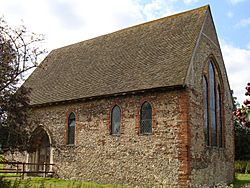Coggeshall Abbey facts for kids

Coggeshall Abbey, capella ante portas, now serving as St. Nicholas Chapel
|
|
| Monastery information | |
|---|---|
| Order | Cistercian |
| Established | 1137-1142 |
| Disestablished | 1538 |
| Dedicated to | St. John the Baptist |
| People | |
| Founder(s) | Gilbert Foliot and Simon de Toni |
| Architecture | |
| Status | Dissolved |
| Site | |
| Location | Coggeshall, Essex, United Kingdom |
| Visible remains | Incorporated into St Nicholas Church |
| Public access | yes |
Coggeshall Abbey was an important monastery located south of Coggeshall town in Essex, England. It was started around 1140 by King Stephen and his wife, Matilda of Boulogne.
At first, it belonged to a group called the Savigniacs. But in 1147, the Savigniac order joined with the Cistercian order. This meant Coggeshall Abbey also became a Cistercian monastery. Monasteries were places where monks lived, prayed, and worked.
Contents
A Look Back: The Abbey's Story
Coggeshall Abbey had a long and interesting history. It saw many changes over the centuries.
Early Challenges and Royal Visits
In 1216, something unusual happened. King John's army visited the abbey. They took twenty-two horses that belonged to the Bishop of London and others. This shows that even important places like abbeys could be affected by royal events.
Later, in 1260, the abbot (the head monk) of Coggeshall Abbey traveled abroad. He was working as an envoy, or special messenger, for the King. This means the abbey and its leaders were sometimes involved in important national matters.
Tough Times for the Abbey
By 1370, the monastery was facing difficulties. Reports said it was very poor. This was partly because of too much spending and other problems with how it was managed.
Then, in 1381, during a big event called the Peasants' Revolt, the abbey was broken into and raided. The Peasants' Revolt was a time when many ordinary people protested against high taxes and unfair rules. This event caused more trouble for the abbey.
The End of the Abbey
The time came when many monasteries in England were closed down. This period is known as the Dissolution of the Monasteries. Before Coggeshall Abbey closed, there were reports of problems with the abbot, William Love. In 1536, he was removed from his position.
By the time it closed in 1538, the abbey owed a lot of money. After it closed, the land was sold to a man named Sir Thomas Seymour.
What Remains Today?
After the abbey closed, its main church was quickly taken apart. However, not everything was lost. A new house was built on part of the monastery's land in 1581, and it is still standing today.
Also, the abbey's gate chapel survived. It has been repaired and is now used as St. Nicholas Chapel. Some other old buildings from the abbey also remain, though their original purpose isn't always clear. These remaining structures help us imagine what the abbey was like long ago.

